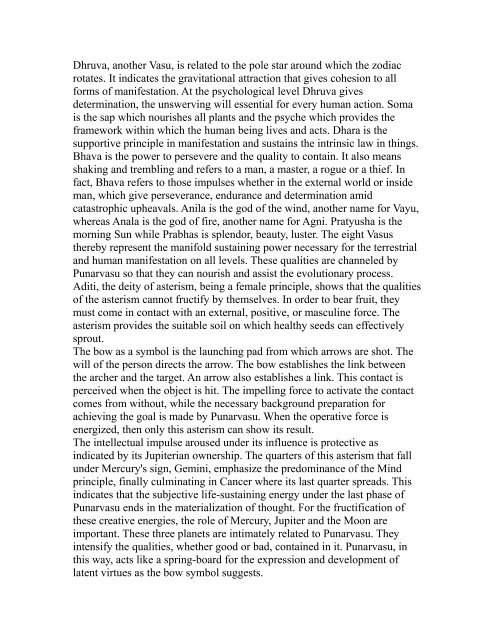Astrological Mythology The Meaning of ... - Mandhata Global
Astrological Mythology The Meaning of ... - Mandhata Global
Astrological Mythology The Meaning of ... - Mandhata Global
You also want an ePaper? Increase the reach of your titles
YUMPU automatically turns print PDFs into web optimized ePapers that Google loves.
Dhruva, another Vasu, is related to the pole star around which the zodiac<br />
rotates. It indicates the gravitational attraction that gives cohesion to all<br />
forms <strong>of</strong> manifestation. At the psychological level Dhruva gives<br />
determination, the unswerving will essential for every human action. Soma<br />
is the sap which nourishes all plants and the psyche which provides the<br />
framework within which the human being lives and acts. Dhara is the<br />
supportive principle in manifestation and sustains the intrinsic law in things.<br />
Bhava is the power to persevere and the quality to contain. It also means<br />
shaking and trembling and refers to a man, a master, a rogue or a thief. In<br />
fact, Bhava refers to those impulses whether in the external world or inside<br />
man, which give perseverance, endurance and determination amid<br />
catastrophic upheavals. Anila is the god <strong>of</strong> the wind, another name for Vayu,<br />
whereas Anala is the god <strong>of</strong> fire, another name for Agni. Pratyusha is the<br />
morning Sun while Prabhas is splendor, beauty, luster. <strong>The</strong> eight Vasus<br />
thereby represent the manifold sustaining power necessary for the terrestrial<br />
and human manifestation on all levels. <strong>The</strong>se qualities are channeled by<br />
Punarvasu so that they can nourish and assist the evolutionary process.<br />
Aditi, the deity <strong>of</strong> asterism, being a female principle, shows that the qualities<br />
<strong>of</strong> the asterism cannot fructify by themselves. In order to bear fruit, they<br />
must come in contact with an external, positive, or masculine force. <strong>The</strong><br />
asterism provides the suitable soil on which healthy seeds can effectively<br />
sprout.<br />
<strong>The</strong> bow as a symbol is the launching pad from which arrows are shot. <strong>The</strong><br />
will <strong>of</strong> the person directs the arrow. <strong>The</strong> bow establishes the link between<br />
the archer and the target. An arrow also establishes a link. This contact is<br />
perceived when the object is hit. <strong>The</strong> impelling force to activate the contact<br />
comes from without, while the necessary background preparation for<br />
achieving the goal is made by Punarvasu. When the operative force is<br />
energized, then only this asterism can show its result.<br />
<strong>The</strong> intellectual impulse aroused under its influence is protective as<br />
indicated by its Jupiterian ownership. <strong>The</strong> quarters <strong>of</strong> this asterism that fall<br />
under Mercury's sign, Gemini, emphasize the predominance <strong>of</strong> the Mind<br />
principle, finally culminating in Cancer where its last quarter spreads. This<br />
indicates that the subjective life-sustaining energy under the last phase <strong>of</strong><br />
Punarvasu ends in the materialization <strong>of</strong> thought. For the fructification <strong>of</strong><br />
these creative energies, the role <strong>of</strong> Mercury, Jupiter and the Moon are<br />
important. <strong>The</strong>se three planets are intimately related to Punarvasu. <strong>The</strong>y<br />
intensify the qualities, whether good or bad, contained in it. Punarvasu, in<br />
this way, acts like a spring-board for the expression and development <strong>of</strong><br />
latent virtues as the bow symbol suggests.
















